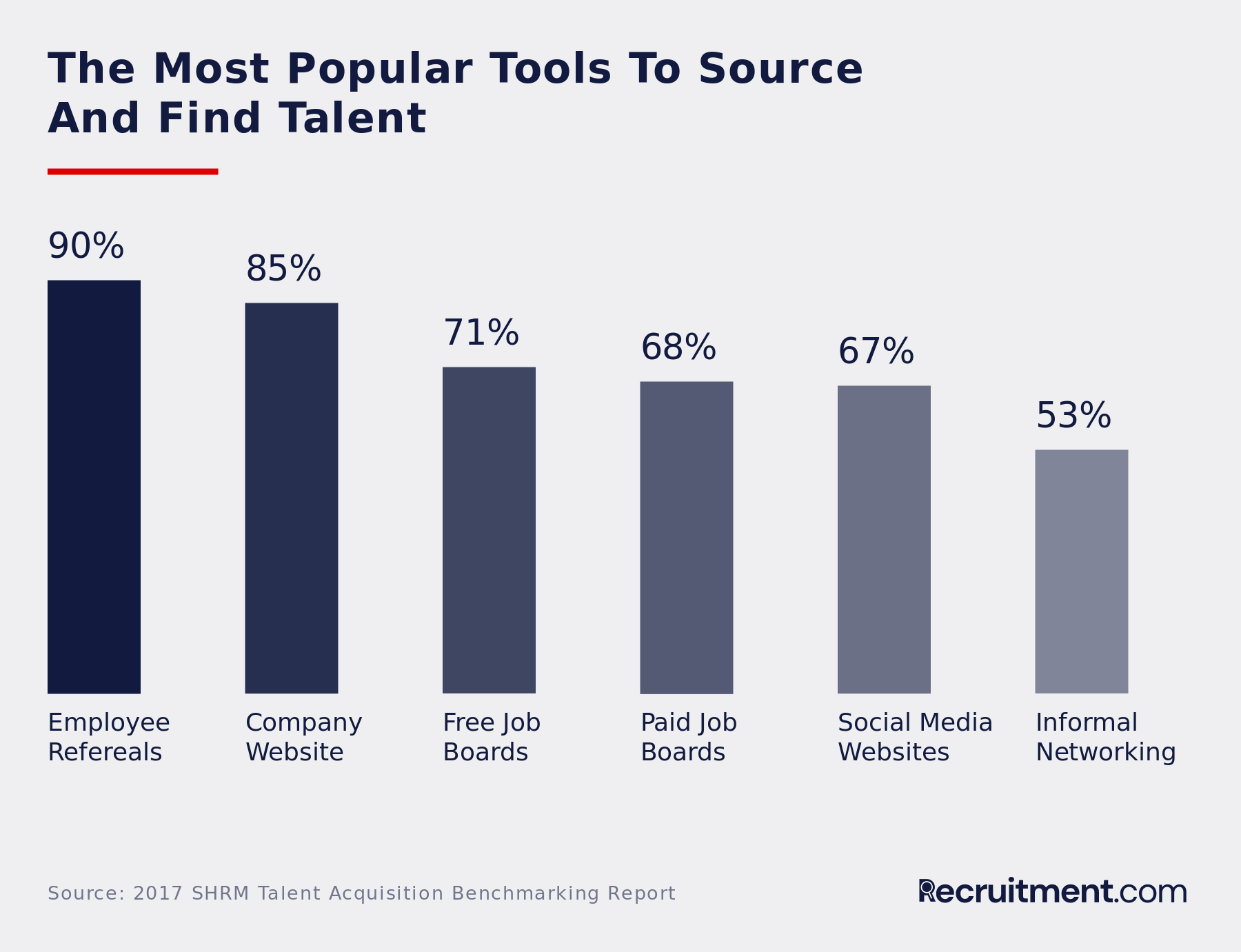What Is Talent Acquisition? The Essentials You Need to Know

Josh Spilker is a writer and editor with more than 15 years of experience covering technology, recruiting, and the future of work.
Next year’s company strategy is in.
- The product team will build several new features.
- Finance will need to review several acquisition opportunities.
- Sales is in growth mode and will expand into new territories
These are just a few common scenarios where talent acquisition would need to be front and center, usually with your human resources or people operations teams.
What Is Talent Acquisition?
Simply put, talent acquisition is finding and attracting people to work at your company, such as finding the best person to do the job well.
The Society for Human Resource Management defines it as “the process of attracting and recruiting the best talent available to ensure your organization has the right people, with the right skills, who are in the right job, and are working against the right requirements.”
This process involves the company Human Resources department along with other key company employees to find, attract, interview and onboard employees.
Talent acquisition can be formal or informal in nature. Formal talent acquisition may include job sites, advertisements and official incentives for your employees. It could also include the team lead or manager making a few calls in their network.
Most often, it is a combination of formal and informal processes to fill a role at your company.
Sounds fairly straightforward, right? However, if you haven’t learned already, talent acquisition can be a roller coaster ride if not done and approached properly.
Is There A Difference Between Recruiting And Talent Acquisition?
Consider these scenarios:
- Phone call for a specific position
- Identifying all of the upcoming hiring needs, budget projections and expansion opportunities
Two activities that are very different, though they may be part of the same department. But think of the difference between recruiting and talent acquisition like this:
- Recruiting is the act of filling a very specific position, such as calling or emailing specific candidates about a role.
- Talent acquisition is a strategic initiative, such as future planning and assessing your future needs, and making the right moves based on your business objectives and growth projections.

The Typical Talent Acquisition Process
The typical talent acquisition process is reliant on these areas. This is the typical “funnel” or process that most people operations and human resource departments will go through for each of their candidates.
Employer branding: The message and branding that companies display to candidates. It is also one of the top ways to improve your strategy.
Sourcing: This is creating an amazing pipeline of contacts to reach out to once positions become available. Only 28% percent of millennials will stay in a job for five years, meaning that switching is all too common. This provides you an opportunity to constantly stay in touch even after an offer is accepted.
Candidate experience: The candidate experience encompasses everything from your job listing on the company website through the onboarding process. That also includes major milestones like the application and interview process. 67% of employed U.S. workers said that the interview, application or negotiation process would influence their decision on taking the position. The candidate experience absolutely plays an important role in the talent acquisition funnel.
Candidate selection. Modern candidate profiles encompass more than a job resume and application. Tech and software centered on this step allow hiring managers and recruiters to add notes and other research--such as from social media profiles. This helps recruiters weigh in on who would be the best option for the position while also streamlining workflows.
Offers, rejection letters and negotiations are also part of this step.
Improvements. Advanced organizations are reviewing each part of their talent management process to make wise decisions about how and where to improve. Data can be mined from candidate surveys, the number of applicants, web traffic, clicks to job postings and more.
But you may also need to improve some parts of your strategy as well. This next section takes a deep dive into where and how to improve.
How Do Companies Source And Find Talent?
In the talent acquisition process, how do recruiters, HR managers and team leaders find great candidates and talent? In a survey of more than 2000 HR professionals, here are the tools that were used most often to find non-executive candidates were employee referrals, the company website, and free job boards.
Depending on the size of your company, it will be very difficult to do all of these activities well. Experiment but decide with your team which sourcing activities best fit your needs. It may also depend on the type of people and personalities that you need.
A college recruiting fair may work for entry-level or associate positions, but may not be the best option for a mid-tier manager.

How Do You Improve Your Talent Acquisition Strategy? Focus On These 6 Key Points.
- Workforce planning. The process of analyzing your company’s current workforce trends, anticipating needs based on business objectives and making the proper budgetary forecasts. Most companies are not very good at this! In fact, only 22% of CEOs said in a recent Harvard Business Analytics survey that they had the ability to model and compare different scenarios with different staffing strategies based on locations, skills, and seniorities; and only 39% have an accurate view of workforce costs.
- Strategic planning. Beyond workforce planning, Human Resources and People departments need to be a vital part of the C-Suite. This is not only to understand future recruiting needs but to also strategically plan for retention. High-performing companies maintain regular communication between the HR department and the top leaders. Less than half of HR departments work closely together with their C-suite counterparts, however, those that do will have to adopt a strategy-driven mindset.
- Employer branding. As mentioned above, employer branding is not only a marketing problem to gain more customers; it’s also a top concern to attract and keep talent. “Every company has a strategy to delight its most important and valuable customers in order to keep them in a long-lasting, mutually beneficial relationship. Innovation and talent-centricity can help employers do the same for their most important and valuable talent,” says Jeff Schwarz, a principal with Deloitte Consulting.
- Sourcing and recruiting candidates. Another important part of talent acquisition is the process of recruiting and sourcing those candidates. The Reinvent Talent Strategies report by Gartner says that filling a position takes an average of 72 days in 2018 compared to only 61 days in 2015. Having a strategy in place to do that quickly and efficiently is huge. The delay of 11 days may not seem too long, but compound that number by several unfilled positions and the additional amount of time could be years of unfilled positions.
- Using recruiting technology & analytics. People and human resource departments are still sorting through the best technology to not only advertise jobs, but to sort, screen and monitor candidates. How you choose your talent acquisition tech stack could have huge ramifications on the efficiency of the company process and has the potential to knock down the amount of time it takes to fill a position. For example, company websites are still the number one tech tool for sourcing candidates, with more than 85% of companies using them. That’s great if they work, but talent acquisition will need a more robust method as more tech gains are made.
- Successful onboarding. One of the benchmarks of a successful company is successfully onboarding employees and creating a positive HR atmosphere for employees. In one sales case study, it’s been proven that only slightly better onboarding practices can have a $1.3M dollar impact on the bottom line.
The more companies are successful at implementing and growing in these strategic initiatives, the more likely they are to be a high-performing organization.
A McKinsey study noted that only 37% of HR respondents said their HR functions create a positive experience. And the ones that even self-report a positive experience correlate to higher organizational performance by McKinsey’s benchmarks.

The Problems Of Modern Talent Acquisition
In a recent report by Gartner, only 21% of HR representatives surveyed said that their current build and buy approaches to talent acquisition felt applicable to their situations.
What’s adding to the frustrations?
More and more specialized roles. As roles become more complex and technically acute, it is more difficult for people departments and organizations to grasp the needs of the role.
Connecting with the right candidates. For the best candidates who have made themselves available, your company or firm is not the only one jockeying for the best candidates. The top-tier candidates are deciding between multiple offers, lifestyle opportunities and benefits. Having a great employer brand will help slice through the confusion.
Matching skills with company needs. In fast-developing industries, like software and engineering, the need for talent may overshadow the available talent. Cultivating talent from within becomes even more imperative. On the flip side, sometimes firms are using outdated technology and can no longer find candidates who have those abilities. There could be a mismatch. In those cases, your workforce has to be aligned with business objectives.
Conclusion: More Than Finding The Best Talent
What is talent acquisition? It’s a multi-layered process that encompasses more than just simply finding and hiring the best talent.
It’s a strategic initiative that impacts the whole realm of your organization. How you plan, organize and function within talent acquisition process has a huge impact on your bottom line. Effective talent management practices actually help companies outperform their competitors.
- What are the areas that could be improved in how your company recruits and onboards talent?
- How will you succeed in finding the next great batch of hires for your company?
- Have you considered how your talent acquisition process will impact your organization for years to come?

Josh Spilker is a writer and editor with more than 15 years of experience covering technology, recruiting, and the future of work.





